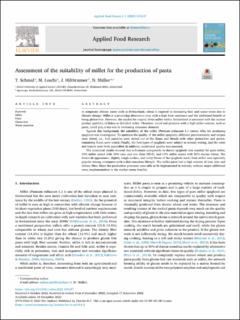Please use this identifier to cite or link to this item:
https://doi.org/10.21256/zhaw-26545Full metadata record
| DC Field | Value | Language |
|---|---|---|
| dc.contributor.author | Schmid, Tamara | - |
| dc.contributor.author | Loschi, Marco | - |
| dc.contributor.author | Hiltbrunner, Jürg | - |
| dc.contributor.author | Müller, Nadina | - |
| dc.date.accessioned | 2023-01-11T09:41:28Z | - |
| dc.date.available | 2023-01-11T09:41:28Z | - |
| dc.date.issued | 2022-12-22 | - |
| dc.identifier.issn | 2772-5022 | de_CH |
| dc.identifier.uri | https://digitalcollection.zhaw.ch/handle/11475/26545 | - |
| dc.description.abstract | In temperate climate zones such as Switzerland, wheat is exposed to increasing heat and water stress due to climate change. Millet is a promising alternative crop with a high heat resistance and the additional benefit of being gluten-free. However, the market for organic Swiss millet within Switzerland is saturated with the current product portfolio of flakes or dehulled millet. Therefore, novel end products with a high millet content, such as pasta, could play a key role in increasing consumer demand. Against this background, the suitability of the millet (Panicum miliaceum L.) variety Alba for producing spaghetti was investigated. To optimize the quality of the millet spaghetti, different pre-treatments and recipes were tested, i.e., hull particles were sieved out of the flours and blends with other gluten-free and gluten-containing flours were tested. Finally, the best types of spaghetti were subject to sensory testing, and the color and texture were both quantified. In addition, nutritional quality was assessed. The analytical results showed that a firmness comparable to durum spaghetti was reached for pure millet, 50% millet mixed with 50% corn and rice flour (95:5), and 15% millet mixed with 85% durum wheat. The brownish appearance, slightly rough surface, and nutty flavor of the spaghetti made from millet was especially popular among consumers with a diet-conscious lifestyle. The millet pasta had a high content of iron, zinc and dietary fiber. Since the production processes were able to be implemented in industry without major additional costs, implementation in the market seems feasible. | de_CH |
| dc.language.iso | en | de_CH |
| dc.publisher | Elsevier | de_CH |
| dc.relation.ispartof | Applied Food Research | de_CH |
| dc.rights | http://creativecommons.org/licenses/by-nc-nd/4.0/ | de_CH |
| dc.subject | Millet | de_CH |
| dc.subject | Pasta | de_CH |
| dc.subject | Gluten-free | de_CH |
| dc.subject | Warm extrusion | de_CH |
| dc.subject.ddc | 664: Lebensmitteltechnologie | de_CH |
| dc.title | Assessment of the suitability of millet for the production of pasta | de_CH |
| dc.type | Beitrag in wissenschaftlicher Zeitschrift | de_CH |
| dcterms.type | Text | de_CH |
| zhaw.departement | Life Sciences und Facility Management | de_CH |
| zhaw.organisationalunit | Institut für Lebensmittel- und Getränkeinnovation (ILGI) | de_CH |
| dc.identifier.doi | 10.1016/j.afres.2022.100247 | de_CH |
| dc.identifier.doi | 10.21256/zhaw-26545 | - |
| zhaw.funding.eu | No | de_CH |
| zhaw.issue | 1 | de_CH |
| zhaw.originated.zhaw | Yes | de_CH |
| zhaw.pages.start | 100247 | de_CH |
| zhaw.publication.status | publishedVersion | de_CH |
| zhaw.volume | 3 | de_CH |
| zhaw.publication.review | Peer review (Publikation) | de_CH |
| zhaw.webfeed | LM-Technologie | de_CH |
| zhaw.funding.zhaw | Abklärung der Eignung von Schweizer Rispenhirse für die Teigwarenherstellung | de_CH |
| zhaw.author.additional | No | de_CH |
| zhaw.display.portrait | Yes | de_CH |
| Appears in collections: | Publikationen Life Sciences und Facility Management | |
Files in This Item:
| File | Description | Size | Format | |
|---|---|---|---|---|
| 2022_Schmid-etal_Suitability-assessment-millet-for-production-of-pasta.pdf | 1.14 MB | Adobe PDF |  View/Open |
Show simple item record
Schmid, T., Loschi, M., Hiltbrunner, J., & Müller, N. (2022). Assessment of the suitability of millet for the production of pasta. Applied Food Research, 3(1), 100247. https://doi.org/10.1016/j.afres.2022.100247
Schmid, T. et al. (2022) ‘Assessment of the suitability of millet for the production of pasta’, Applied Food Research, 3(1), p. 100247. Available at: https://doi.org/10.1016/j.afres.2022.100247.
T. Schmid, M. Loschi, J. Hiltbrunner, and N. Müller, “Assessment of the suitability of millet for the production of pasta,” Applied Food Research, vol. 3, no. 1, p. 100247, Dec. 2022, doi: 10.1016/j.afres.2022.100247.
SCHMID, Tamara, Marco LOSCHI, Jürg HILTBRUNNER und Nadina MÜLLER, 2022. Assessment of the suitability of millet for the production of pasta. Applied Food Research. 22 Dezember 2022. Bd. 3, Nr. 1, S. 100247. DOI 10.1016/j.afres.2022.100247
Schmid, Tamara, Marco Loschi, Jürg Hiltbrunner, and Nadina Müller. 2022. “Assessment of the Suitability of Millet for the Production of Pasta.” Applied Food Research 3 (1): 100247. https://doi.org/10.1016/j.afres.2022.100247.
Schmid, Tamara, et al. “Assessment of the Suitability of Millet for the Production of Pasta.” Applied Food Research, vol. 3, no. 1, Dec. 2022, p. 100247, https://doi.org/10.1016/j.afres.2022.100247.
Items in DSpace are protected by copyright, with all rights reserved, unless otherwise indicated.